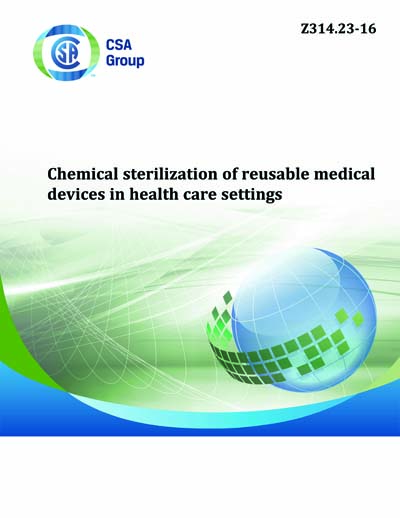Historical
CSA Z314.23-2016
Z314.23-16 - Chemical sterilization of reusable medical devices in health care settings
Preface
This is the second edition of CSA Z314.23, Effective chemical sterilization in health care facilities. It supersedes the previous edition published in 2012. It is one of a series of CSA Group Standards dealing with the safe and effective sterilization of medical supplies and equipment. This Standard is a procedural and equipment guide for health care facilities using chemicals in liquid, gaseous, or vapour form to provide low-temperature sterilization. Its aims are twofold: to help achieve an adequate level of sterility assurance, and to protect from injury staff and patients who might be exposed to a sterilant or its by-products. This new edition has been revised to align with CSA Z314.0. This Standard emphasizes a systems approach, recognizing that sterility assurance and the safety of personnel are dependent not only on reliable operation of chemical sterilizers, but also on proper pre- and post-sterilization practices. CSA Group acknowledges that the development of this Standard was made possible, in part, by the financial support of the governments of Alberta, British Columbia, Manitoba, New Brunswick, Newfoundland and Labrador, Northwest Territories, Nova Scotia, Nunavut, Ontario, Prince Edward Island, Québec, Saskatchewan, and Yukon, as administered by CADTH.Scope
1.1 This Standard specifies essential elements for using chemical processes to sterilize medical devices in health care settings, with the object of achieving an adequate level of sterility assurance and minimizing the risk of injury to health care setting personnel and patients. Note: The term health care setting includes, but is not limited to, hospitals, free standing surgical centres, nursing homes, extended-care facilities, clinics, medical and dental offices, and health units in industry. See CSA Z314.0 for a more comprehensive definition. The following chemical sterilants are currently approved for use in sterilizers in Canada and are addressed in this Standard: a) gaseous and vapourized chemicals:- i) ethylene oxide; ii) hydrogen peroxide; iii) hydrogen peroxide-ozone; and
- i) peracetic acid.
Content Provider
CSA America, Inc. [csa]






